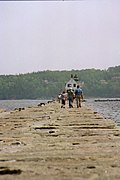 | |
 | |
| Location | Rockland Harbor, Rockland, Maine |
|---|---|
| Coordinates | 44°06′14.55″N69°04′39.16″W / 44.1040417°N 69.0775444°W |
| Tower | |
| Constructed | 1888 |
| Foundation | Stone Breakwater |
| Construction | Brick |
| Automated | 1964 |
| Height | 7.5 m (25 ft) |
| Shape | Square, with attached dwelling |
| Markings | Red Brick Tower |
| Heritage | National Register of Historic Places listed place |
| Fog signal | HORN: 1 every 15s |
| Light | |
| First lit | 1902 |
| Focal height | 39 feet (12 m) |
| Lens | VRB-25 |
| Range | 17 nautical miles (31 km; 20 mi) |
| Characteristic | Flashing white every 5s |
Rockland Breakwater Lighthouse | |
| Built | 1902 |
| Architect | Glover, W.H., Co. |
| Architectural style | Colonial Revival |
| NRHP reference No. | 81000067 [1] |
| Added to NRHP | March 20, 1981 |
Rockland Harbor Breakwater Light is a historic lighthouse complex at the end of the Rockland Breakwater in the harbor of Rockland, Maine. Replacing a light station at Jameson Point (the northern end of the breakwater), the light was established in 1902, about two years after completion of the breakwater. [2] [3] Now automated, it continues to serve as an active aid to navigation. The light was added to the National Register of Historic Places as Rockland Breakwater Lighthouse on March 20, 1981. [1]


